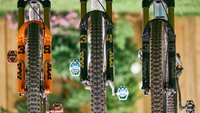Posted by: andy-eunson
Posted by: syncro
Yup, talk test is legit, I use it almost everyday at work with new clients/patrons. But the talk test is for signaling the low end of the aerobic zone and is used for warm-ups or low level aerobic work, it corresponds to about 60-70% of max HR.
So I ride alone most of the time. But if I’m talking to myself and someone happens to see me….? After many years of participating in endurance type sports I know that going by feel is not good enough. Heart rate is a great tool though. If I can’t elevate my heart rate I’m probably tired. If my pulse doesn’t slow return a normal rate after a good effort, it may be time to go home or take a shorter route. But a rider needs to know or have good idea of what their individual max rate and anaerobic threshold is too. 220 minus your age might work, but it might be way off like it is for me.
Just to close this off, your breathing rate is actually a pretty good indicator of how hard you're working. It's not going to give you exact bpm or get you to within few percentage points of the intensity that your working at, but if you have some experience in correlating it with your bpm, even just measured at your wrist or carotid, you can get within about +/- 5% (my estimate) of your workload. Your breathing rate is tied to your heart rate and your body's demand for oxygen, so heart and lungs work together. I know you know this, but once people are able to match their breathing rate to HR it's a pretty good indicator of how hard you are working and it's a simple and free. Here's a couple of links for anyone interested in reading more. Funnily enough an article from Garmin does a good job of explaining the correlation between HR and breathing rate.
And from an article looking at wearable devices for measuring breathing rate or respiration frequency rate - ƒR
"ƒR plays an important role during exercise as a strong marker of physical effort, more so than other traditionally monitored physiological variables. The non-linear increase of ƒR during incremental exercise parallels the well-known time course of blood lactate (La−), resembling the change in physical effort and task difficulty experienced at exercise intensities above the first ventilatory threshold. In fact, ƒR better reflects physical effort than La− when an incremental test is performed after exercise-induced muscle damage (Davies et al., 2011) or glycogen depletion (Busse et al., 1991). This suggests that physical effort is more causally linked with ƒR than La−."









